Text
That’s an interesting point to consider! Thematically, I’d pair Sisu with Fang, Pengu with Heart, Amba with Tail, Pranee with Talon, and Jagan with Spine. Pengu is the leader who refused to accept defeat and Sisu was given the dragon gem to save the world. This is paralleled by Raya of Heart refusing to give up hope and Namaari of Fang being given the gem pieces to put back together and save the world. Amba’s power is light, which represents hope, which keeps us going, propelling us forward like the dragon’s Tail. Pranee’s power is shapechanging to people, a disguise that lets Sisu experience human life, which is mutable, murky and tricky to navigate, as she learns from Talon’s bustling community of fast dealers and con artists. Jagan’s power is fog, which represents protective and defensive force, valued by the people of Spine, who live behind fortified walls surrounded by fog.
Kumandra has five regions, Sisu is one of five siblings.
There’s gotta be a connection here
80 notes
·
View notes
Text
This reminds me of the very funny joke at the end of CinemaWins’ video on RATLD. You also raise a very significant point: Namaari has no idea what Raya’s talking about because she wasn’t around for all the “found-family/magic-of-friendship adventure” (and she doesn’t know how Sisu and her siblings saved the world through trust).
Given her lack of context, Namaari is impressively quick to pick up on how trust lies at the heart of their problem. (I’m referrring to how she brings up the issue of trust at the end of their last fight, out of all things she could be saying. Her choice of words in that scene is an interesting peek into what’s going on inside her.) She’s massively behind the movie’s lessons on trust and playing catch-up through the climax. And befitting of a leader and representative of Fang, which occupies the head of the dragon, she proves herself a quick study by correctly figuring out what needs to be done, despite not having much context or information to guide her.
Namaari is also the only one during the climax who actively shows willingness to listen to Raya, by asking for clarification instead of arguing back like Boun and Tong. So the “WHAT” shows a subtle shift in her relationship with Raya (following the look they share after working together to evacuate Tuk Tuk and the last of Fang’s people). They’re finally starting to work on the same wavelength, based on mutual understanding and belief that they're on same side. The problem they face now is how to get the others on board with accepting Namaari as part of the team.
(On a side note, there are some really funny moments in RATLD that I didn’t appreciate until after coming to better understand its storytelling through analysis and research. For example, Sisu’s “Wait till you see my backstroke” and “Ooh, it’s really hot! Captain Boun, we need water on deck!” became hilarious when I realized their hidden meanings. I’m dying to post about them, but there’s so much more that I need to talk about before I can explain what’s so funny.)
the climax of raya was incredibly well-done but it also has the FUNNIEST moment in the movie by FAR when raya was like “it was never about the magic it was about the trust :)” and namaari, who has not been here for her entire found-family/magic-of-friendship adventure and literally isn’t even on good terms with these people just goes “WHAT”
216 notes
·
View notes
Text
Who’s Wahn and Why’s Namaari So Mad at Him?
Who’s Wahn? This guy...
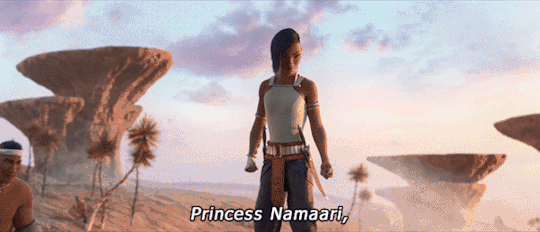

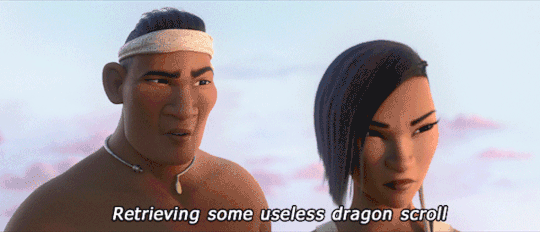
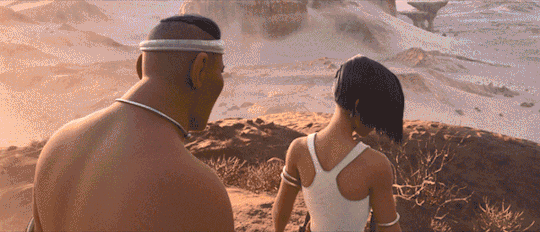
...who gets a smackdown for questioning why they’re out there.
This scene is where we see Namaari for the first time after she breaks Raya’s trust. She’s now an intimadating warrior, apparently one with an explosively short fuse who smacks around her own underling for daring to question her. Her treatment of Wahn further frames Namaari as the villain of the story.
But I feel this picture doesn’t quite match up with the Namaari that’s revealed by the end of the movie—poised and well-mannered, passionate and expressive but restrained and disciplined. She’s certainly an angry teen (as the screenplay describes her)...

...but taking out her anger through physical violence like she does to Wahn? Namaari only shows such behavior towards one other person—Raya, her nemesis born of a complicated and traumatic history, the one pushes her buttons.
(In fact, while making the above image, I realized that even the angry faces Namaari makes are mostly directed at Raya. Of the 9 screenshots I chose, only the bottom right one isn’t—that’s from when Tong calls her “the one who slayed Sisu.” Namaari’s anger issues are definitely tied to Raya and we’ll talk more about that below.)
So I wondered why Namaari’s so mad at Wahn. What buttons did he push?
Then I noticed that Wahn isn’t dressed like the other Fang soldiers:
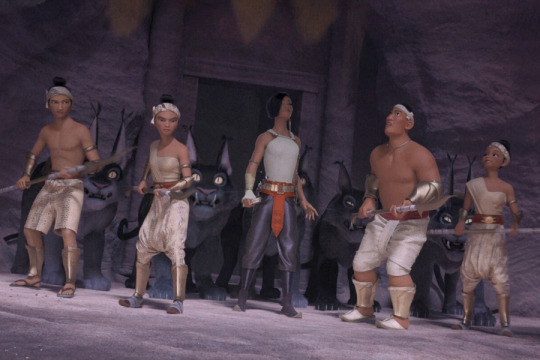

But there is someone dressed just like him...
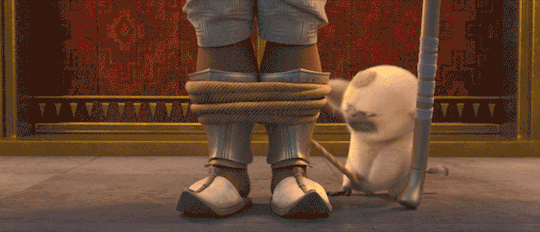
...the guard watching one of the gates of Fang Palace.
So with this in mind, let’s talk about how Wahn may have triggered Namaari’s anger.
A. What Is Wahn?
Well, we can safely guess that Wahn isn’t just a soldier in the royal army—he’s a palace guard.
We can also speculate that he was probably the guard on duty when Raya infiltrated the palace to steal the dragon scroll, by incapacitating him and using his key to get inside (much like Noi and the Ongis). Being sent on the dangerous task of chasing the thief through Druun-infested lands would have been the punishment for failing his duty.
Supposing the above, we can explain the harshness of Namaari’s reaction when he suggests that they forget about Raya and the scroll. Instead of making up for his failure by capturing the thief and recovering what was stolen, he’s trying to shorten his punishment by convincing Namaari to abandon their mission.
What’s worse is that he’s still displaying the complacency and negligence that led to his failure to guard the gate and prevent the theft. He doesn’t even see that retrieving the scroll isn’t what’s truly at stake. Because what makes their mission worth the risk is keeping Fang safe by determining what Raya’s up to and neutralizing any threat may she pose by capturing her.
B. Why Is Namaari So Angry?
It’s important to note that chasing Raya is manifestly a threat response for Namaari. Twice, she fiercely demands to know what Raya’s up to, why she’s stealing gem pieces. To Virana, she worriedly insists that Raya shouldn’t be underestimated and must be stopped.
So first, Namaari shows anger, especially when Raya evades her. Then, safely at home and to her trusted mother, she reveals a more vulnerable underlying emotion—fear.
Yet Raya doesn’t seem to have done anything so very threatening. She did successfully infiltrate Fang, but only to steal a scroll that's not useful for anything. Stealing the gem pieces is more concerning, but it’s not like they do anything other than repelling the Druun (and Fang is well-protected from the Druun by water).
Virana (who’s all about keeping Fang safe) certainly isn’t very worried about what Raya's up to. She advises Namaari not to make emotional decisions, implying that her need to stop Raya is irrational. And Namaari, unable to offer evidence to the contrary, pivots her argument to the benefits of gaining more gem pieces, in order to convince Virana to lend her the royal army.
Then why is Namaari so afraid? Why does she view Raya as a threat that must be dealt with? Because she caused Raya so much harm and irreparable loss. Her attempt to take the dragon gem led to the breaking of Heart and the world. And Raya came back to life from presumed death, broke into Fang, and took what was used to lead her to treachery. And Namaari doesn’t know what this ghost risen from her past sins will do if not stopped. Guilt leads to fear and fear leads to anger.*
Namaari’s guilt is so deeply repressed that it mostly only surfaces in the form of fear and anger. And—rather than proving a lack of remorse—her treatment of Raya as a threat, her angry and fearful gestures of aggression, can be understood as the product of a deep and overwhelming sense of guilt that she’s unable to properly process or express.
(*That’s not to say that Namaari’s psychology can be reduced to this simple formula. There's more going on, like how the problem of scapegoating factors into her aggressive defensiveness. And the pull of shared connection and attraction, of course, which complicates things even more.
To dig a bit deeper, I refer you to an article by an actual psychologist: “Anger: How We Transfer Feelings of Guilt, Hurt, and Fear.” Applying this article’s insight to Namaari’s case, we can also explain her anger as a psychological defense used to distance herself from distressing experiences such as feeling afraid, powerless, accused, guilty, ashamed, untrustworthy, unloveable, etc.)
C. Back to Wahn
Let’s wrap up this discussion by counting the buttons that Wahn manages to push:
1. “the Tail lands are infested with Druun” (Yes, an entire land has been destroyed by a plague caused by Namaari’s actions. Duly noted. Two down, three left.)
2. “Benja’s daughter is as good as stone” (Might as well have said, ‘lol Raya’s totally gonna die and, hey, remember how she lost her father thanks to you?’)
3. "useless dragon scroll” (Not that Namaari believes Sisu’s still out there, like some 12-year-old, but nobody likes to be reminded that there’s no way to fix the world they broke.)
4. Putting their safety before before their duty and mission. (A quality that Princess Selfless-Hero-Complex wouldn’t appreciate in her palace guard, especially one who failed at his job.)
5. Failing to treat a threat to Fang seriously. (See sections A & B.)

Namaari: Anyone else wanna push my buttons? (#incorrect quotes #Raya don’t)
#get your act together Wahn#and somebody get Namaari a therapist#raya and the last dragon#ratld#disney raya#namaari#wahn#this started as a quick fun-fact post but ended up a long rambling#character analysis
113 notes
·
View notes
Text
"Taller, stronger, angrier” is such a perfect summation of Namaari, post-skip. She grew up into an angry teenager.
(It’s interesting how Namaari compares with Raya in this respect. They both grow up into angry teenagers who are mad at the world and at themselves. But Raya’s anger is mostly held in check and denied full expression until their final fight. While for Namaari, anger is the one emotion she gets to express freely, and her other emotions are revealed only in brief glimpses and sublte hints.)
I think I first learned Wahn's name from the junior novelization. He’s also called Wahn in the credits—voiced by Cambodian American actor François Chau.
Fun fact: Wahn is not dressed like the other Fang soldiers. This adds another layer to why Namaari is so angry with him. (Will post more on this later.)

We have a name for the man who dared to question namaari😟
I’m sorry I’m enjoying reading through this way too much-
38 notes
·
View notes
Text
LOL “slightly drunk” I love that. Now I can’t unhear the hint of drunken slurring when he says that line. (It’d be fun to see more of the Dang Hu, Dang Hai, and Chai family interacting, like in a sequel or a short where the Kumandra team gets involved in some hijinks in Talon.)
I also like how the Tail Chief is “extra-paranoid”. I think there’s a tendency for people to put down the other chiefs’ motivations to greed, when there’s more going on. Their words here tell us that the other lands’ hostility against Heart is rooted in more than greed—they feel robbed (especially Tail, which has been suffering the most environmental damage) and threatened (the Spine Chief even sees the dragon gem as a weapon).
Their actions are driven by the same motivations that also drive Raya’s actions, after her betrayal and loss. (And their sense of dispossession is not unfounded, since the dragon gem was not Heart’s to ‘own’ in the first place—it was a legacy made by Sisu’s siblings for all of Kumandra.)
I see the Tail Chief’s fate as a warning, not against greed, but against giving fear free rein to drive our actions. Her paranoia, her fear of being robbed, leads her to a path of extreme isolation and irreparable destruction. Fear is a useful emotion that helps ensure our survival and safety, but it can also blind us and lead us astray. And both Raya and Namaari must learn to avoid this path of destruction, by reining in the fears that drive them to harmful actions.
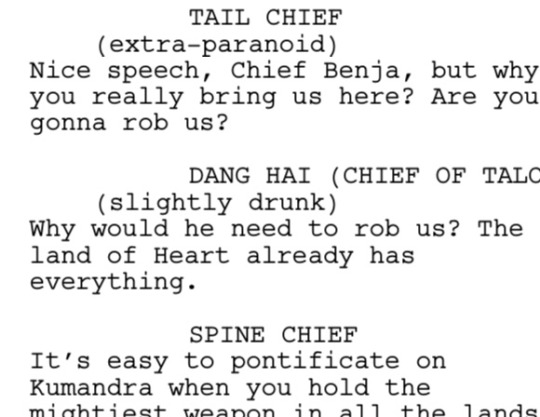
I found the screen play of RATLD…
I love how it says the talon chief was “slightly drunk”💀
#Thanks for posting this! I didn't know the screenplay is available online and immediately went searching for it.#It's pretty interesting to compare the screenplay and the final product.#raya and the last dragon#ratld#disney raya#screenplay
21 notes
·
View notes
Text
Thanks for sharing your thoughts! I think RATLD is a hard movie to get, even more so if the characters and their stories don't pull you in and make you care to learn to know them better. Because it's a movie that asks for a good amount of care and work from its audience to understand what it wants to say.
(It is a different kind of movie from the classic Disney musicals. If that's more your thing, I'd agree that in that sense, RATLD wasn't made for you. But the recently released Encanto may be more to your liking, if you haven't seen it yet.)
I do want to point out that RATLD is not a movie made to please most people. It's the result of creators pushing beyond making a decent story to make one that's flawed and difficult to understand, by pushing deeper into exploring trust as a remedy to a real crisis our own world is facing now—social division and tribalism run amok (what the Druun represent).
The result is an allegorical poem wearing the cloak of a predictably conventional fantasy action adventure. It zooms through all the stuff a decent, satisfying fantasy story would offer, in the interest of examining how to make trust work as a remedy to destructive social division.
There are no unnecessary characters in this poem. Its main cast is already cut down to the minimum needed—one group project member from each of the five lands, one parent for the protagonist/hero/project leader and another for her foil/antagonist/anti-villain, and one dragon. Each plays an essential part in the full message of the movie.
You see, RATLD's primary goal is not to please us with easy-to-consume entertainment, it's to teach us how the power of trust can be harnessed to work for us instead of against us in our time of crisis, by learning to work together as one team in a group project.
I call RATLD a poem because its mode of storytelling is heavily metaphorical, condensed, and layered. Piecing together its full, complex meaning demands a good lot of homework (best done as a group by discussing and sharing our views of the movie).
RATLD calls for active engagement in learning its metaphorical film-language; attention to detail and careful study through repeat viewing; a bit of research for helpful knowledge and context that the movie doesn't quite cover; critical observation and thinking; openness to considering different perspectives, even those we think are wrong.
For example, the fast pace makes it easy to miss, but Namaari only fires the crossbow accidently when she uses it to block Raya's attack. I think this would have been better shown in slow motion. In freeze-frame, we can confirm that Raya jumped the gun—Namaari is not pulling on the trigger when she notices Raya's incoming attack.
Namaari's perspective is focused on this fatal moment. And what's important isn't whether she's right to say Raya's just as much to blame (most would disagree)—but that her words help Raya recognize a truth to which she was blind in her justified anger at Namaari: They share the commonality of being flawed people with trust issues whose actions contributed to outcomes no one wanted.
This recognition not only stops Raya from killing Namaari (who they need to turn in their group project and bring everyone back), it also allows her to hear the other project members doing what's more important than fighting and lashing out at those we blame—pitching in to take care of the problem at hand. And it gives her the clarity, compassion, and courage needed to take the first step that finally leads every project member to come together as one team and complete their group project.
(Hopefully, my reading above helps their final fight and its resolution make more sense, if not more satisfying. What I'd like to do most of all through my long, rambling posts is help RATLD make more sense to those who feel moved by its final message of hope. To help along the movie's goal of helping us find real hope and empowerment, through better understanding its difficult lessons on trust.)
Disney Movie Marathon #59 Raya and the Last Dragon (2021)
I saw this one in theaters! I'm pretty sure I liked it more than Frozen 2 but again a lot is happening and it feels like it's happening really fast. And I was having some realizations during the movie that made me sad. The style of the movie was cool though but still not a huge fan of the dragon design. And I was having some realizations during the movie that made me sad. When I first saw this movie the thing that made me sad is the thought that Disney isn't making movies for me anymore. These past recent movies the plot had either been too simple, they dumb it down for jokes, they're clearly trying to sell a toy somewhere, and it feels like the creative teams are being rushed or made to cut something because it needs to please the most people as possible and not make a decent story first. My relationship with Disney is a complicated one.
Keep reading
13 notes
·
View notes
Photo
I sincerely hope this response doesn’t come off as rude, but I just needed to share my appreciation for the above because I find it genuinely funny. And seeing it brightened my morning after waking up tired from working for days on analyses... of how a lot of Raya’s problem comes down to how she doesn’t know Namaari very well, with these two scenes as my main examples.
One of Raya’s primary flaws (and what I find funny and endearing about her) is how she tends to confidently claim to know things that she actually doesn’t. (It’s not that she’s often wrong, more that she’s often not entirely right.)
Someone recently pointed out to me the ubsurdity of Raya’s opening narration: “I know what you’re thinking. A lone rider. A dystopian world. A land that’s gone to waste. How did this world get so broken?” The ubsurdity being, she says this during the very first seconds of the movie, when we the audience haven’t seen enough to learn any of the things she “knows” we’re thinking.
In fact, what’s happening is the movie is telling us through Raya what we should be thinking going into this story: She’s a lone rider, this is a dystopian world, the land’s gone to waste, the question we should be asking is how did this world get so broken. It’s a situation report to quickly ground and prep us for the story we’re going to be told. (It’s gotta be quick because there’s not much time and lots to tell.)
And prefacing this situation report with Raya’s claim to “know” what we’re thinking is a way of poking fun at her tendency to be confidently wrong about what she thinks she knows.
(I see a lot of complaints about the jokes in this movie, but imo where the humor really shines in RATLD is in its meta-jokes, which are subtle and a bit self-deprecating in the way they poke gentle fun at the shortcomings of its characters and storytelling.)
Later, Raya gives Sisu and us another “Here’s the sitch” report that turns out to be somewhat inaccurate in its details. Raya is a somewhat unreliable narrator and we need to learn to be wary of trusting her knowledge and view of the world too much, or we’ll be blind to the things she doesn’t fully know.
Going back to the gifs, on the left, Raya thinks she knows exactly what to give Namaari... but the gift doesn’t work as intended. On the right, Raya knows how to push Namaari’s buttons... but she doesn’t know how not to push them. Put left and right together and what we get is Raya heading towards a confrontation with Namaari that doesn’t go as Sisu planned.
(Though I agree that Namaari is Raya’s beloved partner and soulmate. They just don’t start getting to really know one other and truly connect the way they’re destined to, until after their fight in Fang.)
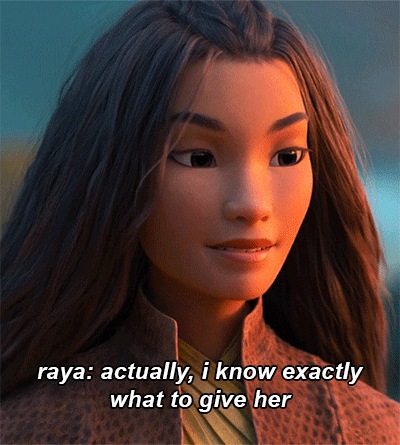

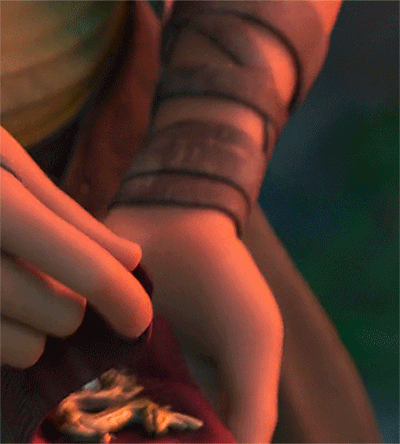


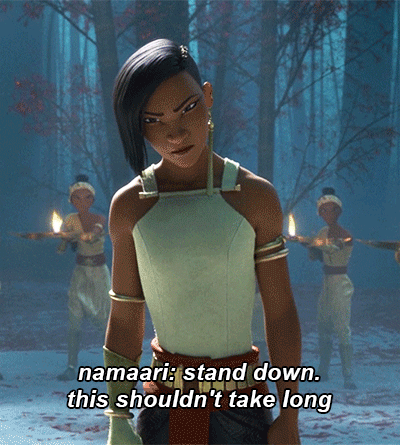
When Raya knows Namaari (Raya’s beloved partner and soulmate) very well
#raya and the last dragon#ratld#disney raya#storytelling#meta humor#raya#knows#namaari#but also doesn't know her#not knowing what she doesn't know is what gets her in trouble#I'm going for a walk now because I'm going blind from staring at my screen writing up drafts that refuse to come together
215 notes
·
View notes
Text
On the contrast between Raya and Sisu, here’s a quote from co-director John Ripa in The Art of Raya and the Last Dragon: “[W]e held on to the fun idea that Raya drives in a straight line and Sisu does nothing in s straight line—everything is sideways, even when she’s trying to be helpful. And you can imagine how that might feel to someone who is trying to get something done.”

The scene where Sisu boasts her swimming ability through rhyme is probably one that many people would point to as cringey and immersion-breaking. But when we watch Raya’s reaction—as illustrated so well with those emojis—that’s exactly how Raya feels too. She finds it cringey and feels taken out of her moment of excitement and admiration at seeing a real live dragon. That disappointment leads directly to the next scene, where Raya dismisses what Sisu tells her about the importance of gifts as another silly thing to ignore.
(That’s what I most love about the jokes in this movie—how they serve the storytelling. And when Sisu says something silly, she’s often telling us something helpful in a sideways way. She speaks riddles that need deciphering before we can appreciate their true meaning. But if we dismiss and ignore the silly things she says, we’ll have trouble understanding what the movie wants to tell us, much like Raya has trouble learning what Sisu has to teach her.)
Their communication problem goes both ways, of course. Just as Raya has trouble taking Sisu’s ideas seriously, Sisu has trouble taking Raya’s fears seriously. As a dragon, it’s hard for Sisu to understand just how hard being people is, although she gets a taste of it thanks to Pranee’s shapechanging power. And when she calls out Raya’s trust issues, what she hasn’t learned yet is that she has trust issues of her own: Sisu errs on the side of trusting too much, too carelessly.
It takes the two of them (Raya who drives in straight lines and Sisu who does everything sideways) practicing and learning to work together, forgiving one other’s missteps and betrayals along the way—to progress in the movie’s task of learning how to better handle the awesome but dangerous power of trust.
One of my favorite things about raya and the last dragon is the contrast between Raya and Sisu.
Especially in that scene where Sisu was like “I’m a wicked when I hit that liquid” and raya was like 😄😀🙂😐🙁😕🤨 tf is she doing
98 notes
·
View notes
Text
Here’s an excerpt from The Art of Raya and the Last Dragon that’s helpful in understanding the film’s visual language:
Driven by story, the cinematography of Raya and the Last Dragon is designed to emphasize Raya's character arc and her distrust of the world outside her own. We wanted trust and distrust to drive our camera and lighting choices, so we set up guidelines based on these themes.
To illustrate the difference between trust and distrust, we chose camera and lighting styles that would contrast with each other. This visual contrast could then be applied sequence to sequence, or even shot to shot, depending on where we were in Raya's story arc.

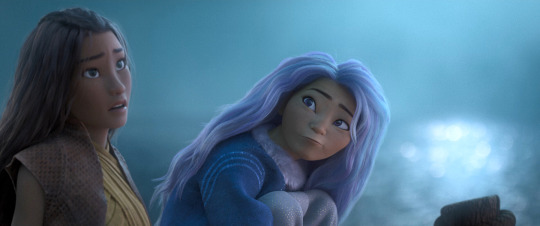
For example, in these film frames, Raya and Sisu are engaged in a disagreement about whether or not they should trust others on their journey. Distrustful Raya was shot with a wide lens, deep focus, and a narrow color palette, while trusting Sisu was shot with a long lens, shallow focus, and a broader color palette.
—Adolph Lusinsky, Director of Cinematography-Lighting, and Rob Dressel, Director of Cimatography-Layout


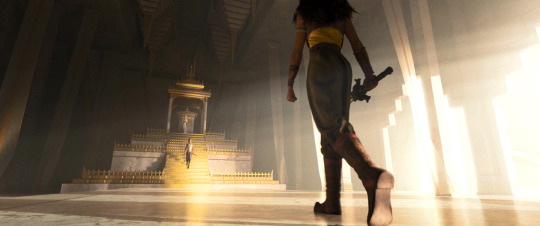
To convey distrust and a fractured world, the team used deep space with a deep focus, a narrow color palette, higher contrast, heavier film grain, and an arid feel with dust and smoke.
Trust and a united world, on the other hand, were communicated through flat space, with a shallow (broken) focus, a broad color palette, lower contrast, lighter film grain, and a feeling of water with rain and mist.
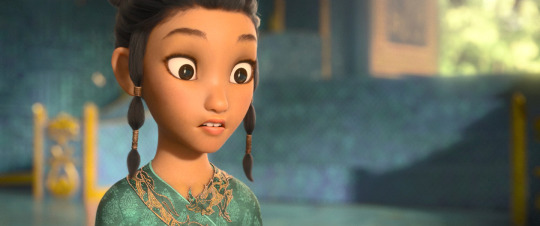
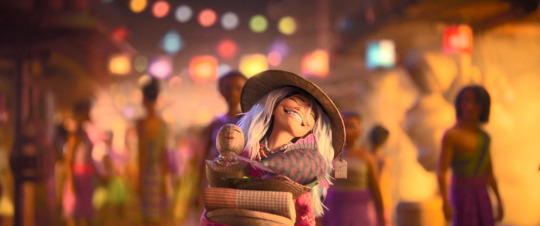

43 notes
·
View notes
Text
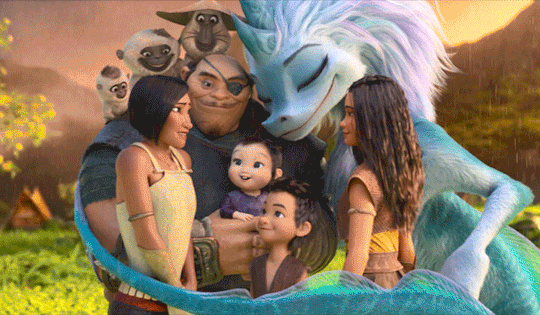
Shout out to my rayaari fandom day ones:
@moon-spirit-yue
@snorlax891
@ratld-fandom-support-blog
@rayasjerky
@faithfulwarrior-og
@mitypie
@shy-peacock
@everyonesfavoritelesbowrites
@rayaari-my-beloved
@ao3feed-rayaari
@ask-atziri
@loveragent-gabb05
@taro-egg
@purplestrawberrywerewolf
@boywth-luv
@textuallee
@teabeeart
@ratld-sideblog
@tuktuk-and-the-last-dragon
47 notes
·
View notes
Text
@boomthedruun Hi, this is in reply to your post here.
(Edit: I very belatedly realized that I messed up the link to boomthedruun’s post when I first posted this. It’s fixed now, so the context for my response below will hopefully make better sense.)
First, thanks for taking the time to write up such a detailed response. I appreciate it, as it helps me better understand why the movie fails to reach some viewers and also to think more about the movie in different ways.
I also apologize for the length of this response. I won't reply point-by-point to every issue you raised since that would be too long and I don't want to impose even more on your time. (If you're interested, I'd be happy to make another post explaining my thoughts on some of the narrative issues you raised. But if not, that's fine too. Rest assured I did read through all of your response.)
After reading your explanation and thinking over things, I realized that what moved me to reply to your original post is this: I feel strongly that it's unjust to take the shortcomings we find in a movie and dismiss them as creative mistakes.
Because sometimes it's the storytellers that make mistakes and fail at the job they set out to do. But sometimes it's the viewers that fail to hear out the story they're telling. (And sometimes it's a bit of both.)
We may not enjoy a movie or feel dissatisfied by how its story is told, and we can and should talk about that. But that doesn't always mean the movie does a poor job of storytelling. Sometimes, the movie does a good job, and we're the ones who weren't prepared to see it.
Of course, we all bring our own expectations and biases (good call on my Sisu profile picture ;) when we watch a movie. But they shouldn't be the guiding criteria when evaluating its storytelling qualities or creative accomplishments. It's important to judge a movie for what it is (or trying to be) and unfair to put it down for not being what we want.
This is especially so for a movie like RATLD. When people explain what they find lacking in RATLD's storytelling, I find that their issues are often rooted in how the movie doesn't do what they expect or want. And that's fair to talk about, but the problem I have is when the issue is attributed to poor storytelling (or a lack of skill or care on the creators’ part).
Here's the thing—I think RATLD does exactly what its makers meant it to do. They want us to experience the disappointment of betrayed expectations, just like Raya does. Because RATLD is at heart an educational movie. It seeks to teach us some difficult lessons about the importance of trust and compassion, how trust really works, how inherently risky it is, and how we can trust more wisely. That's why its storytelling is so protagonist-centered (at the expense of better showing the rest of the world and other characters)—to take us on a journey of learning to trust more wisely, much like Raya's.
On this journey, we find that Raya betrays us by proving a somewhat unreliable narrator. Sisu betrays us by being unimpressively goofy and naive. Benja betrays us by being not very inspirational. (Benja's speech is unimpressive because they want to show us that he's an unimpressive speechmaker. The bridge scene characterizes him as a man doing something he's not ready for, because he believes he has to.) What the story is asking us to do is look past their failure to live up to our expectations, so that we can appreciate who they really are and what they have to teach us.
(I want note here that I didn't arrive at these conclusions without struggling with this movie and my own views about where its storytelling falls short. For example, I also felt it was a mistake for them to make it so protagonist-centered. As I kept studying the movie and thinking on what I may be missing, I came to better appreciate why they chose to do it. I love RATLD because it inspires me to work hard to love it, not because I find it flawless.)
As an epic adventure story in a fantasy world, RATLD falls short of the level of detailed exposition and world building we expect from such stories. This is a deliberate storytelling choice. It's not because these creators don't know how to tell a good epic fantasy. And it’s also not because they want to take easy shortcuts in telling their story. They took those shortcuts as a means of reaching their most important storytelling goal—showing and telling us all the movie’s lessons on trust. Because that's what our world needs right now.
I see the makers of RATLD as the Benjas, Sisus, and Rayas of our world—storytellers who took a brave and necessary step. They didn't take the safe route of making a conventional adventure story with an easily digestible message, something familiar that would satisfy the majority of the audience. They took the dangerous route of telling a story that's harder for us to digest (because its lessons are complicated and hard to teach and learn). And they took the risk of making a movie that's easily misunderstood, with the hope that we'll be forgiving toward its faults and accept its lessons as gifts crafted with care and given in earnest. I evaluate their creative work very highly for this.
Now, creative achievement is not the only kind of evaluation we can make regarding a movie. And you raise a very valid point on how the movie's approach to representing Southeast Asia (or the marketing of it as such) can be offputting. As a Korean who finds Korean American literature hard to enjoy, I can sympathize with this kind of discomfort.
And of course, I can't dispute you on the point of emotional impact, since that's subjective. But I'm glad you found Encanto so impactful and enjoyable (especially after being disappointed with RATLD). For me, both movies are emotionally impactful in different ways.
Lastly, I want to point out that movies like Moana and Frozen 2 were stepping stones to the heights they're reaching now. After all, storytellers can't grow and improve their craft if they don't try new and different things and learn from the experience. I think it's wonderful that Disney animators are still striving to grow and raising the bar so high on movies that are different from each other, like RATLD and Encanto. This might be the start of another golden age for them—how exciting is that? :)
11 notes
·
View notes
Text
Thinking over similarities between Namaari and Sisu, and it just occurred to me that Namaari plays the Dragon to Chief Virana lol (There’s no way the people who made this movie don’t know about tvtropes, yeah?)
11 notes
·
View notes
Text
Look at Those Cheeks!



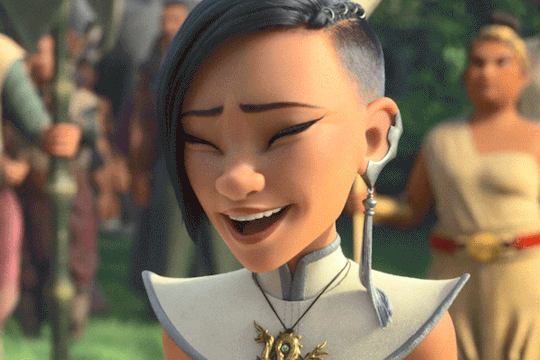
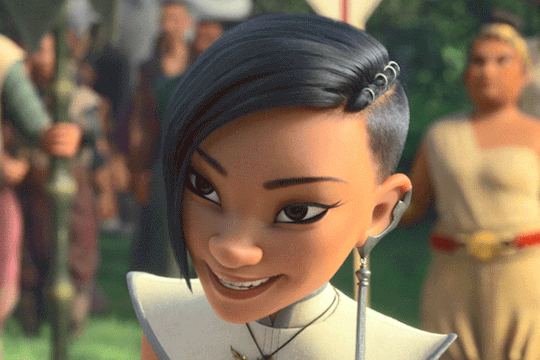
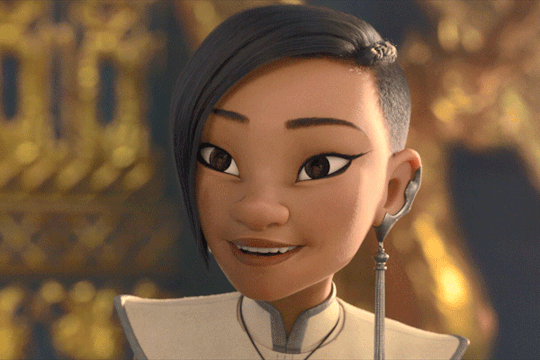
So let’s talk about dimples in Raya and the Last Dragon.
First of all, Namaari has dimples.
Well, 12-year-old Namaari does. 18-year-old Namaari doesn’t. Dimples are one of the things Namaari lost while growing up. (To read more on this, see “How Does a Kitten Become a Tiger?”)
There are three other characters in the movie who have dimples. I like to think of these dimples as hints to help us connect the dots between these four characters.
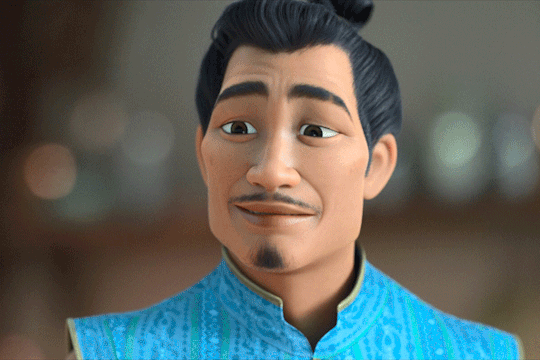
Benja and Namaari share the ideal of a better world—a unified and harmonious Kumandra. The difference is that Benja believes they can still be Kumandra again, even without dragons, but Namaari believes it’s an impossible child’s dream that she must give up.
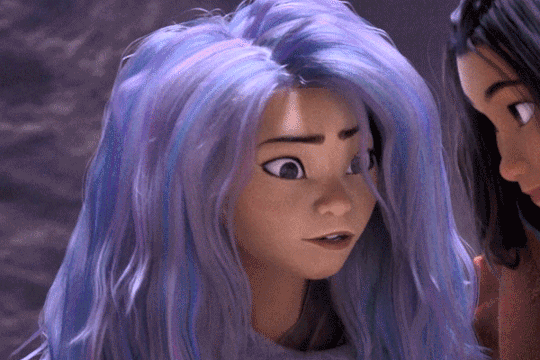
Like Benja, Sisu believes Kumandra can be revived and sees trust as the key to accomplishing this. With this belief, they try to mentor Raya on her hero’s journey (although both make mistakes they pay for with their lives).
Sisu and Namaari connect to each other like two magnets, bound by the power of trust. Sisu trusts Namaari as no one else does, with zero doubt. And Namaari in turn trusts Sisu with what she most holds dear and fears for—her people. (Unfortunately, they're interrupted by Raya before she can make this clear.)

Like Namaari, Tong is a fierce warrior born and bred to protect his people. Beneath the facade of a menacing villain, we find a gentle-hearted caregiver who loves children.
Like Benja, Tong is a father who lost his child (except Benja lost his by throwing her in the river to save her life). When Raya sees her father’s likeness (and her own) in Tong, she’s able to take a big first step in learning to trust people again. (Meeting Boun and Noi were smaller first steps that prepared her for this one.)
Tong helps Sisu learn how to make trust work again for the people of this broken world. They infiltrated Spine, confronted Tong, gave him some really nice gifts (Raya’s trust, new friends to end his loneliness and a little one to take care of, and the hope of bringing his village back to life), and he offered to help them.
Sisu applies this lesson to someone she just realized wants to fix the world as much as they do. She finds it hard to convince her friends to go with her plan, because what she saw deep down in Namaari’s eyes is hard to see for those who aren’t dragons (or don’t trust dragons).
And here’s where I end this long post, with a thank you for reading and a sorry but I told a little lie:
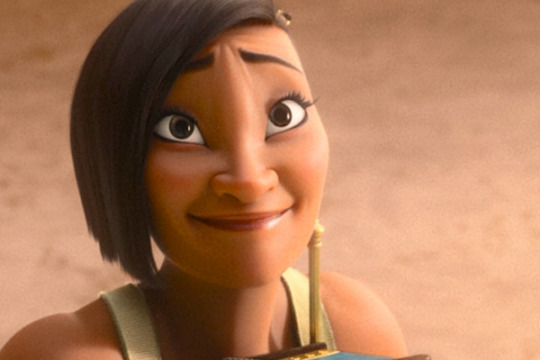
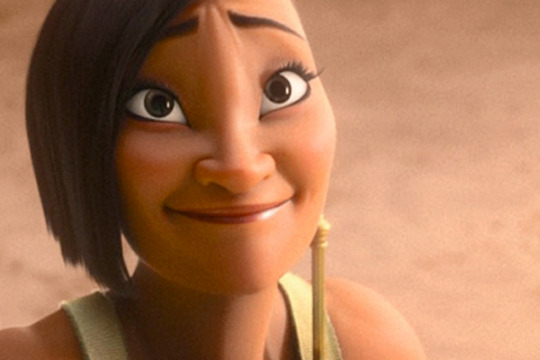

Like her dream of a better world, Namaari never truly lost her dimples. They just became much harder to see.
(And these elusive dimples are even harder to capture as images. If you study certain shots closely frame-by-frame, during the duel at Spine for example, you may catch hints of them at the corners of her mouth.)
#raya and the last dragon#ratld#disney raya#namaari#sisu#benja#tong#raya#if you want to get Raya's trust bring her a pair of dimples#or lose your familiy to the Druun that works too#Tong is big and scary-looking so they gave him both#i had so much trouble making these gifs Namaari your dimples cost me six years and gave me a world of pain but i forgive you
67 notes
·
View notes
Text
Ah, I never noticed that Heart’s territory is the smallest. (Though it looks fairly close in size to Spine.)

Fang is more mountainous than Heart and Talon, which may mean they have less arable land, or at least land suitable for rice farming.
(But my pet theory on the cause of the rice shortage Namaari mentioned is crop disease or pests. That would explain why they wanted the gem so much, since its one confirmed power was wiping out the Druun plague.)
Spine is the most mountainous (and coldest) and probably has the least amount of farmable land. (But they have an abundance of bamboos.)
It looks like Heart and Talon have the biggest branching rivers. But Talon is further away from the Dragon River’s source (which is in Fang, at the dragon’s crest). So a lot of their territory turned drier after the dragons were gone.
Tail, being the furthest away from the source, got the short end of the stick and turned into a desert. 500 years ago, their rivers must have been big enough for ships to sail to the furthest end (where Raya found the shipwreck).
(Another pet theory of mine is that Sisu being asleep at the Dragon River’s end was what kept that tiny stream of water running. Like the dragon gem pulling water up the steps in Heart’s temple, Sisu’s presence may have kept Tail from drying up completely.)
It’s likely that after the gem broke, Kumandra as a whole became even dryer. (We don’t see rain again until Sisu gains Pengu’s magic.) Fang would have been the least affected by this, contributing to their relative prosperity (and to being scapegoated by the other nations).
When the water returns at the end of the movie, we see the water level rising as it passes through Talon and into Tail. This shows that, with the return of the dragons, all the lands will become as properous as 500 years ago.
Maybe you didn't notice, Heart is actually the smallest nation in Kumandra. But happen to be in the best environment with rivers run deeply into the land, and their landscape is mostly delta and tropical forest, so it is suitable for rice agriculture and other food and fruits. second prosperous land is Talon, then Fang, Spine and lastly Tail. Another fact about Tail is that according to the map, 500 years ago, while dragons still around, Tail is much more prosperous, with more green and larger rivers. But ever since dragon gone, Tail slowly gets drier and drier and became a desert land in the present day.
30 notes
·
View notes
Text
So I think this post makes a lot of great points and I agree with most of them. But I want to suggest going a couple of steps further, especially from the last paragraph...
The message of Raya and the Last Dragon is: 1. Try not to trust blindly. And 2. Trust others because we ourselves are not always trustworthy.
1. This is a point that's often misunderstood. The movie actually shows us that trusting blindly is dangerous.
Benja trusts the people he invited blindly and things go badly. Raya trusts Namaari blindly twice and things go badly. Sisu trusts Dang Hu blindly and things go badly. She later trusts Raya blindly (because she doesn’t understand her trauma) and things go badly.
(The third time Raya trusts Namaari, it works out because she’s not trusting blindly this time. She has a better understanding than before of both Namaari and herself.)
The key word here is try, because we're all blind to some degree when it comes to knowing other people (and even ourselves). So giving trust is always a risky venture, but one worth taking. And it's best taken with caution and a clear view of the situation.
2. The movie shows us that dividing people between the trustworthy and the untrustworthy doesn't work, because we can't divide people that way. Anyone can be both trustworthy and untrustworthy. (That's why it's not about deserving, i.e. who is worthy.)
Benja fails to live up to the trust his people and his daughter placed in him as a chief and a father. Sisu fails to live up to Raya's faith in her as a mighty savior of the world.
Raya fails to uphold the duty entrusted to her as a guardian of the gem. She steals Talon's gem from Dang Hu and lies to Tong about wanting to steal Spine's, so they have reason to not trust her (but Tong still does).
Raya also keeps Sisu in the dark about her intention to steal Talon's gem, abusing the trust Sisu gives her. And later she betrays Sisu's trust at the worst moment, not because she wants to but because she feels she has no choice.
Namaari doesn't betray Raya because she's untrustworthy. Her most defining features are her pride in living up to her mother's trust and her loyalty and selfless service to her people. It's because she's a trustworthy daughter and guardian of Fang that she feels she has no choice but to break Raya's trust.
So trustworthiness is not a magic dividing line that can keep us safe from harm or betrayal. Nor is it a trait some people have and others don't. It's a process we all live through, because we all make mistakes and can break the trust others give us, whether we want to or not.
And we can't live through this process and truly grow, if we don't forgive the mistakes we make in our life-long course of learning to give, accept, and keep one another’s trust. We must also be brave and not let the fear of making mistakes and getting hurt stop us from trying again.
That's the real lesson of Raya and the Last Dragon. (And yes, it's amazing and I love it!)
can’t believe this is an unpopular opinion, but Raya and the Last Dragon (2021) was amazing. A lot of people liked the movie and the history/heritage behind it but not the message of the movie. and while i 100% adore and appreciate the heritage, the message was what made me love the movie.
people think that the message is wrong to say we should trust those who are untrustworthy or who have given us reasons not to trust them, that Namaari and Fang didn’t deserve forgiveness or trust in the movie.
but that’s exactly the point- it’s not about deserve. Raya and the Last Dragon is 100% a reflection not only of Southeast Asian culture, but of our world today. especially in regard to politics, we don’t trust each other, we don’t work together, and we let fear divide us. In the movie, Raya realizes that while Nemaari may not be the most trustworthy person, someone has to take the first step in working together to fix the world. and that’s so important.
today, it’s so much easier for us to say that we shouldn’t have to take responsibility for a problem just because we didn’t start it. it’s easy to point fingers instead of join hands. but that’s not the way to improve things. sometimes you have to trust and come together not because the other person deserves it, but because the world does.
and that’s exactly the message Raya and the Last Dragon conveys- not necessarily trusting blindly, but trusting others because WE ourselves are trustworthy, and it’s the only way to truly grow.
148 notes
·
View notes
Text
So this is just something of a rant while my other posts are slow-cooking in the pot, but...
I think saying that Raya and the Last Dragon should have been a series is like saying an epic poem should have been a novel.
I don't mean that one can't prefer novels. (I prefer novels and read hardly any poetry). And I don't mean that the world, its characters, and their stories wouldn't make a good novel.
(Editing belatedly to add: I also don’t mean to discourage discussions about how the movie could be done differently as a series. It’s another great way to share our thoughts on something we’re fans of. And it shows how creative works can inspire our own creativeness.)
What I mean is that it feels like people are pointing at an epic poem and saying, "This novel is too short and needs more fleshing out," while its finer qualities as a poem go underappreciated.
This film’s storytelling is a lot more substantial and sophisticated than it tends to get credit for. And I think that's because people expect it to speak like a novel when it speaks more like a poem.
Much of its language is coded—highly visual (and musical too), compact and layered, metaphorical and subtle. It relies on a dense network of repeated and overlapping images and motifs to carry much of its meaning.
And it asks for a lot of interpretive work (and curious and open engagement) from its viewers to learn what it says beyond a surface-layer action adventure story that can be enjoyed without too much effort.
All of this is just to say, I'm very glad they made Raya and the Last Dragon as a movie because I find it a fantastic work of storytelling.
#raya and the last dragon#ratld#disney raya#not that I think this movie is flawless or couldn't have benefited from a bit more runtime#but it's still an artistic achievenment
16 notes
·
View notes
Text
That's...interesting to know...
I'd say Raya and the Last Dragon's moral perspective is based on Buddhist philosophy. It examines how to end suffering by learning to see the world compassionately past misconceptions that blind us.
This is probably one of the most significant Southeast Asian cultural influences in the movie, but not a topic I've seen people discuss.
(Although I did see a youtube comment on the likeness of something in Sisu’s resurrection scene to a Buddhist symbol called the unalome. Which is what led me to link the movie to Buddhist philosophy.)
People looking at Disney movies set in precolonial times: This movie is about Christianity somehow.
15 notes
·
View notes